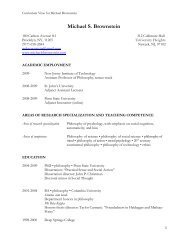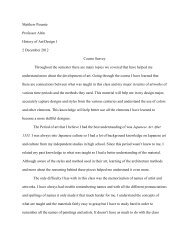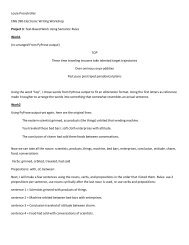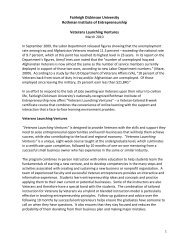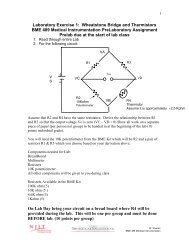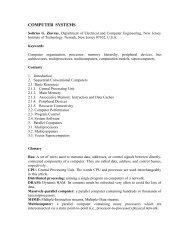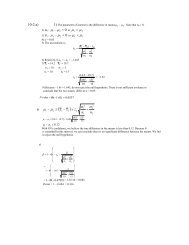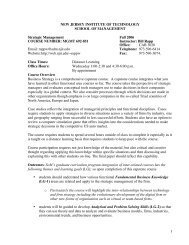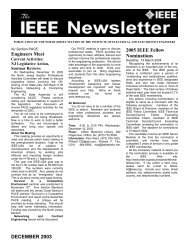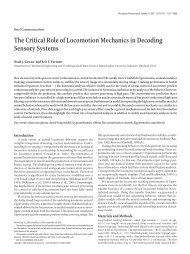Well-conditioned boundary integral formulations for the ... - Njit
Well-conditioned boundary integral formulations for the ... - Njit
Well-conditioned boundary integral formulations for the ... - Njit
Create successful ePaper yourself
Turn your PDF publications into a flip-book with our unique Google optimized e-Paper software.
and thus are Fredholm operators in <strong>the</strong> spaces H m− 1 2<br />
div<br />
(Γ), m ≥ 0. If in addition η ≠ 0 and ei<strong>the</strong>r<br />
Rη ≥ 0, Iη ≤ 0, Rζ ≤ 0, Imζ ≥ 0 or Rη ≤ 0, Iη ≥ 0, Rζ ≥ 0, Iζ ≤ 0, <strong>the</strong> <strong>integral</strong> equations (10)<br />
are uniquely solvable in <strong>the</strong> spaces H m− 1 2<br />
div<br />
(Γ), m ≥ 0 <strong>for</strong> sufficiently large values of κ 2 .<br />
Proof. The result in equation (26) follows from those established in Lemma 2.1 and<br />
Lemma 2.2. Clearly, in <strong>the</strong> light of equation (26), <strong>the</strong> <strong>boundary</strong> <strong>integral</strong> operator that enters <strong>the</strong><br />
CFIER <strong>for</strong>mulation is Fredholm in <strong>the</strong> spaces H m− 1 2<br />
div<br />
(Γ), m ≥ 0. Consequently, <strong>the</strong> invertibility of<br />
this operator is equivalent to its injectivity. To establish its injectivity, let a be a solution of equation<br />
(10) with E i = 0. It follows that <strong>the</strong> electromagnetic field (E s , H s ) defined by equations (8)-(9) is an<br />
outgoing solution to <strong>the</strong> Maxwell equations in <strong>the</strong> unbounded domain R 3 \D whose <strong>boundary</strong> values<br />
E s + on Γ satisfy <strong>the</strong> homogeneous conditions n × E s + = 0. In view of <strong>the</strong> uniqueness of radiating<br />
solutions <strong>for</strong> exterior Maxwell problems [29, 44] we obtain E s = H s = 0 identically in R 3 \ D. It<br />
follows <strong>the</strong>n from <strong>the</strong> standard jump relations of vector layer potentials given in equations (5) that<br />
<strong>the</strong> interior traces of <strong>the</strong> electric and magnetic fields defined in <strong>for</strong>mulas (8) and (9) satisfy <strong>the</strong><br />
relations<br />
−n × E s − = a, −n × H s − = Ra, on Γ.<br />
Taking <strong>the</strong> scalar product of <strong>the</strong> second of <strong>the</strong>se relations with <strong>the</strong> conjugate of <strong>the</strong> first one, using<br />
standard vector relations, integrating over Γ and appealing to <strong>the</strong> divergence <strong>the</strong>orem gives<br />
∫<br />
∫<br />
∫<br />
(Ra) · n × ādσ = (Ēs − × H s −) · n dσ = −ik {|H s −| 2 − |E s −| 2 }dx. (27)<br />
Γ<br />
D<br />
We have<br />
and<br />
Γ<br />
∫<br />
Γ<br />
Γ<br />
∫<br />
Γ<br />
∫<br />
(n × S K a) · (n × ā)dσ =<br />
Γ<br />
S K a · ādσ (28)<br />
∫<br />
TKdiv 1 Γ a · (n × ā)dσ = n × ∇ Γ (S K div Γ a) · (n × ā)dσ<br />
Γ∫<br />
−−→<br />
= − curl Γ (S K div Γ a) · (n × ā)dσ<br />
∫Γ<br />
= − (S K div Γ a) curl Γ (n × ā)dσ<br />
∫Γ<br />
= − (S K div Γ a) div Γ ādσ. (29)<br />
In conclusion we obtain from equations (28) and 29 that<br />
∫<br />
∫<br />
∫<br />
(Ra) · n × ādσ = η S K a · ādσ − ζ (S K div Γ a) div Γ ādσ.<br />
Thus, denoting by η = η R + iη I and ζ = ζ R + iζ I we get that<br />
∫<br />
R (Ra) · n × ādσ = η R R{S K a, a} − η I I{S K a, a}<br />
Γ<br />
Γ<br />
Γ<br />
Γ<br />
− ζ R R{S K div Γ a, div Γ a} + ζ I I{S K div Γ a, div Γ a}. (30)<br />
Given that <strong>for</strong> K = κ 1 + iκ 2 with κ ≥ 0 and ɛ ≥ 0 we have <strong>the</strong> following positivity relations which<br />
follow from equations (25)<br />
R{S K a, a} > 0, I{S K a, a} ≥ 0, R{S K div Γ a, div Γ a} ≥ 0, I{S K div Γ a, div Γ a} ≥ 0 (31)<br />
10



